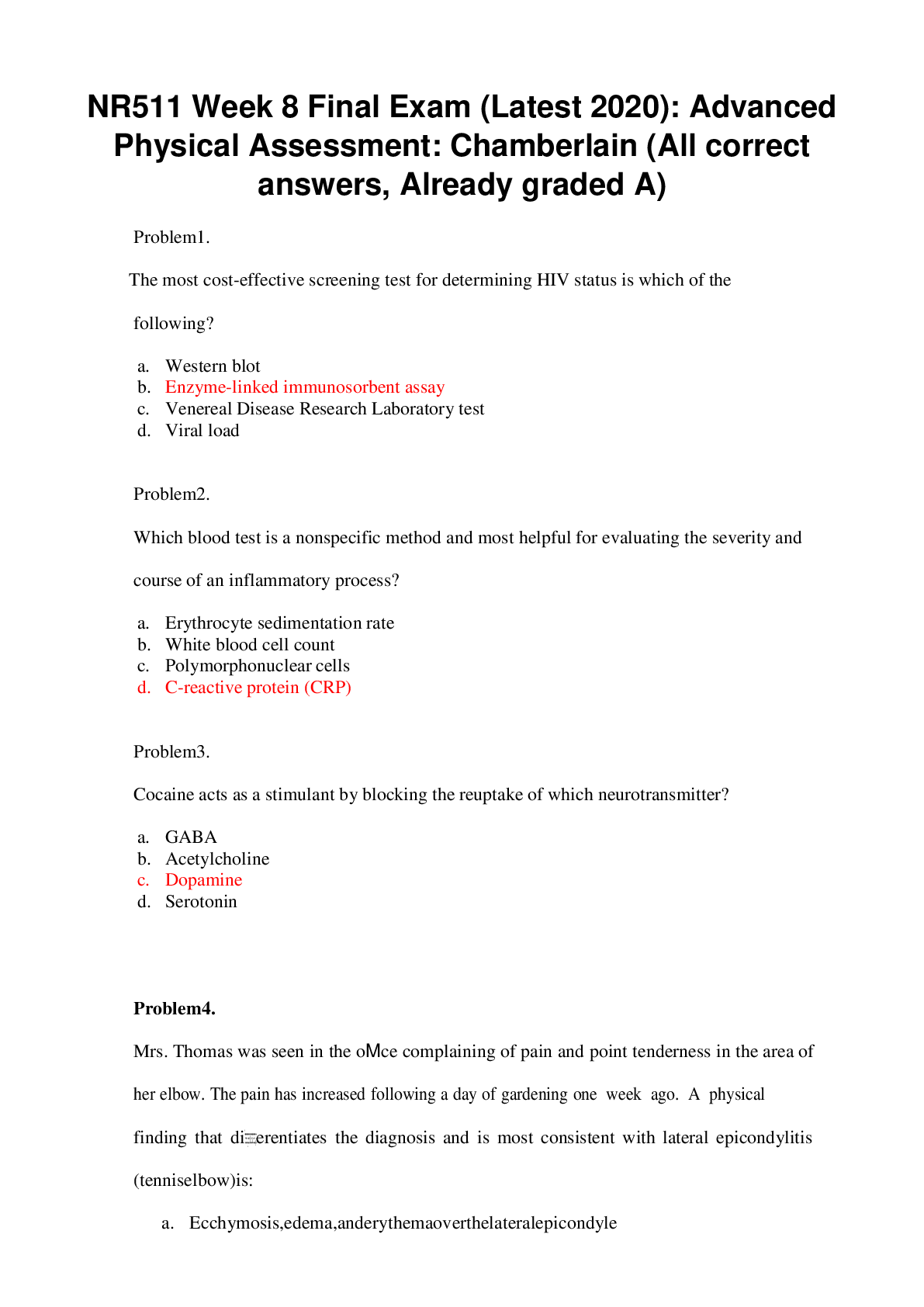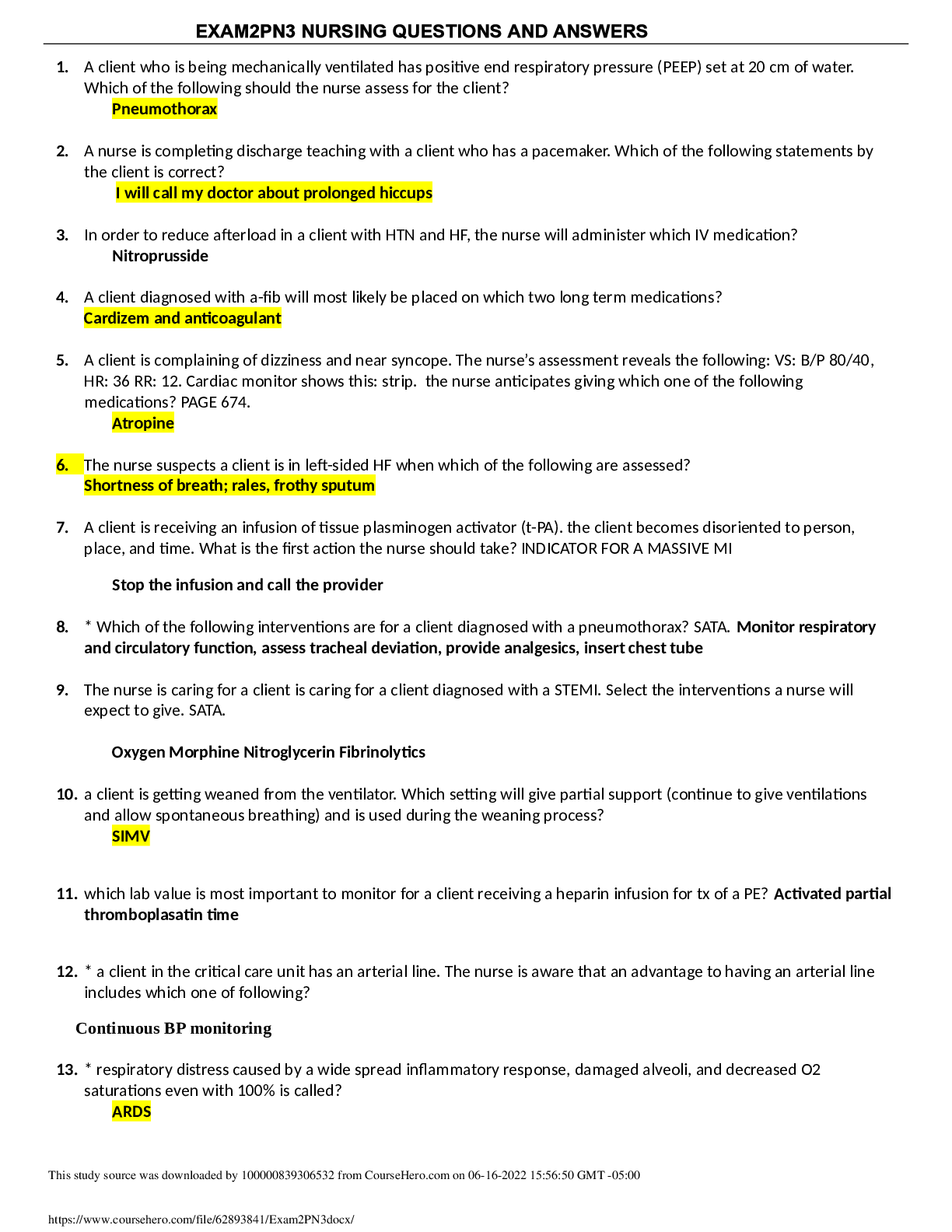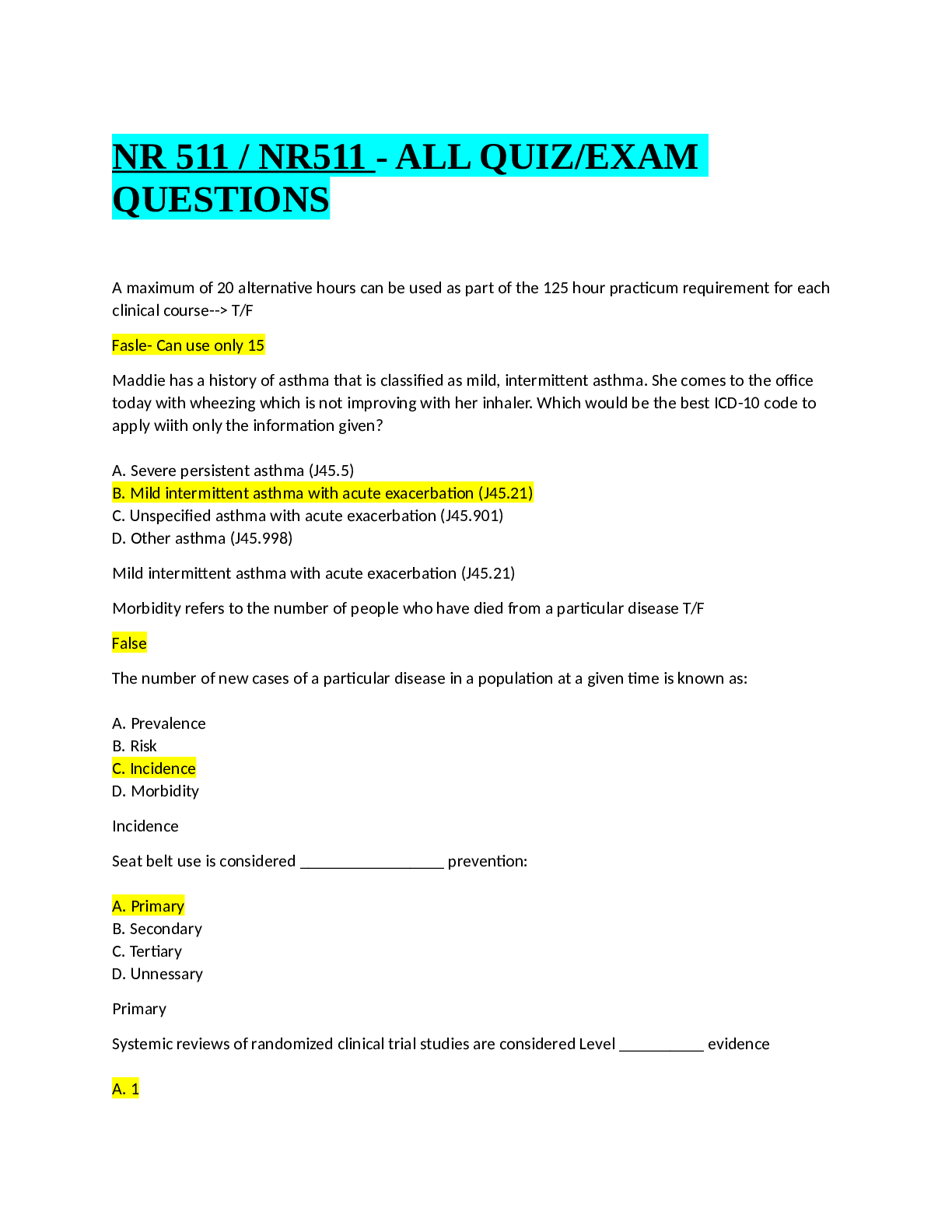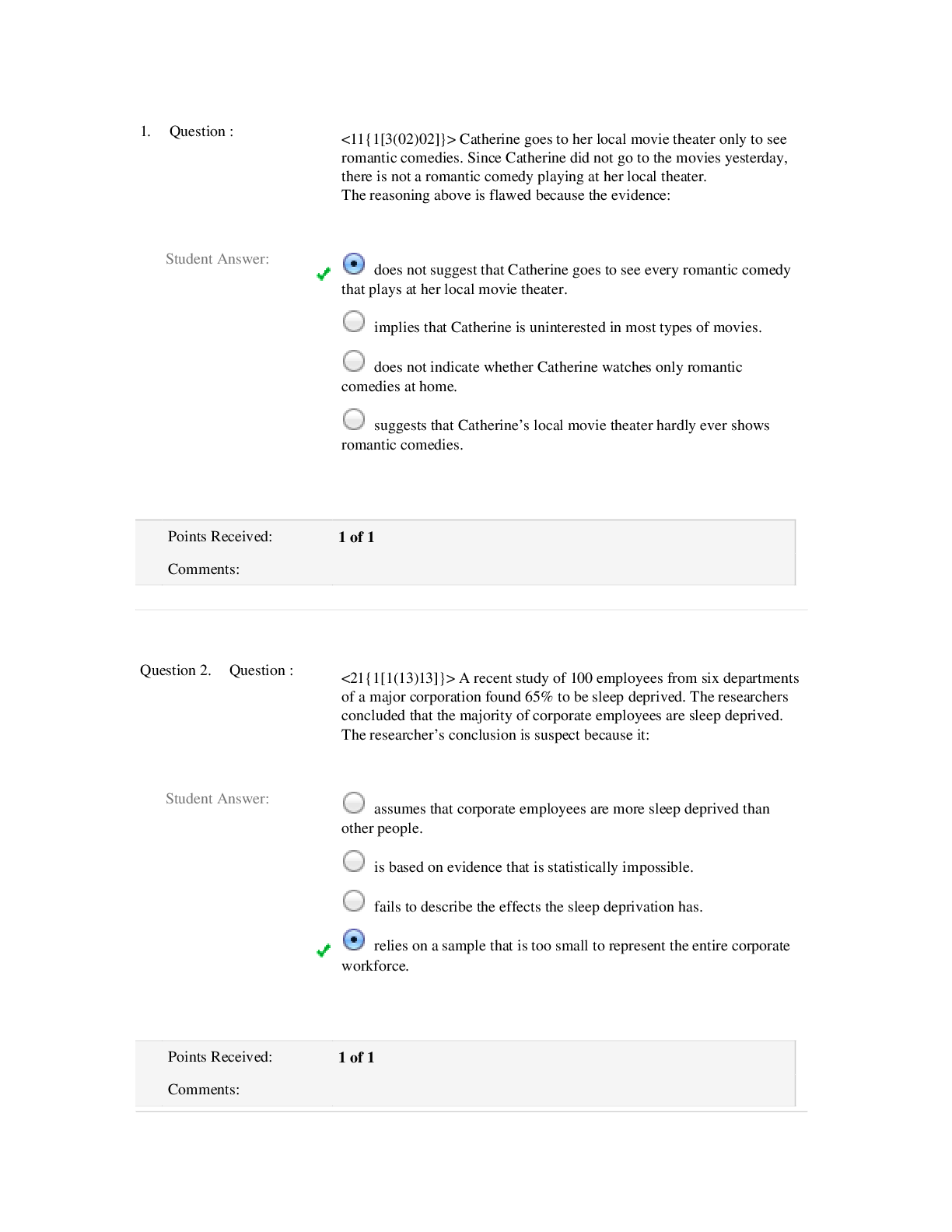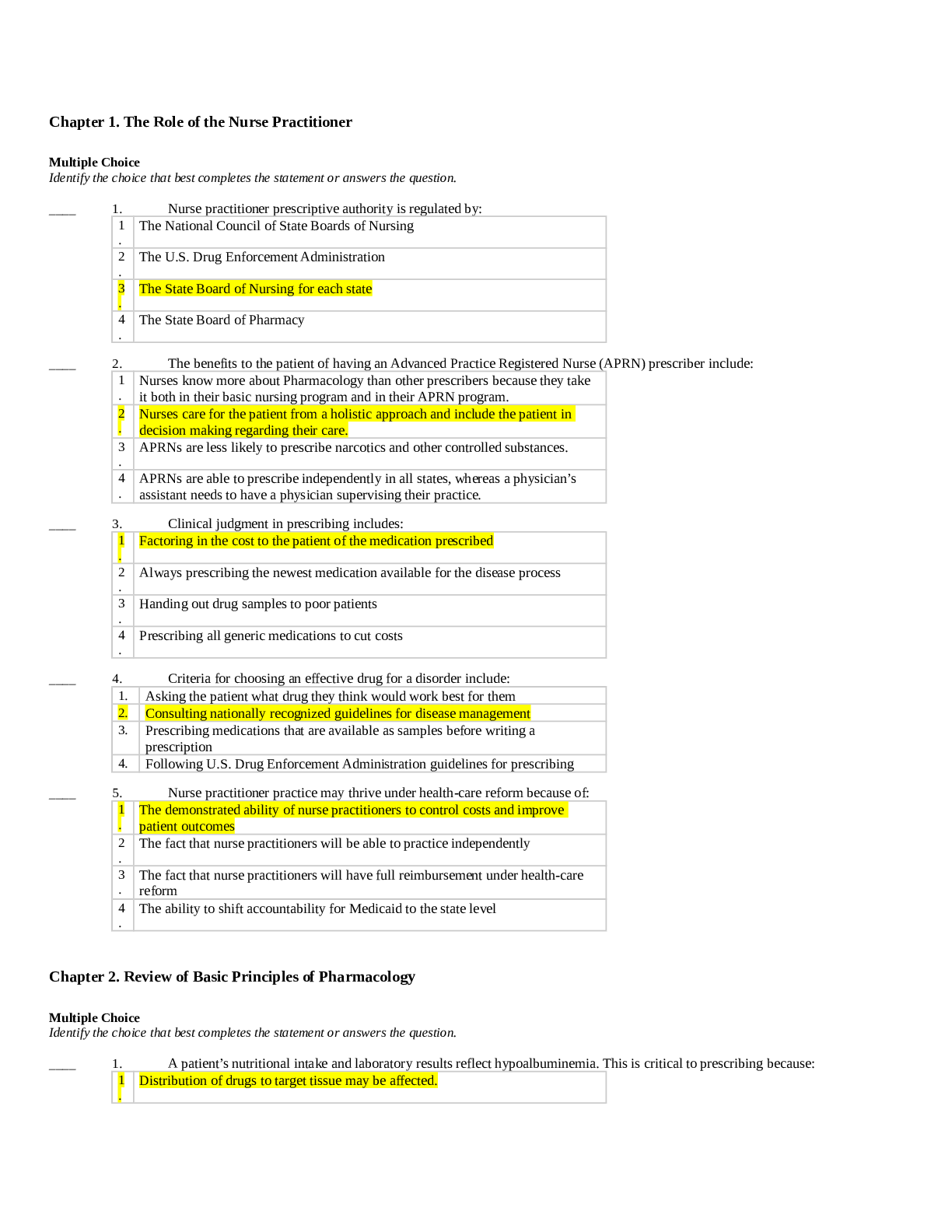*NURSING > QUESTIONS & ANSWERS > NUR 440 QUIZ Questions & Answers, Already graded A. (All)
NUR 440 QUIZ Questions & Answers, Already graded A.
Document Content and Description Below
NUR 440 QUIZ Questions & Answers 1. A nurse is working in a long-term care facility. Which of the following clients should the nurse recommend for treatment first? A. a 59-year-old female client who... was accidentally given an excess dose of beta blocker with a heart rate of 118 beats per minute B. a 72-year-old female client who has a history of chronic stable angina and depression who fell last night with a small bruise on her knee C. an 84-year old male client whose low-density lipoprotein (LDL) level is more than 200 mg/dL and a high-density lipoprotein of 20 mg/dL D. an 83-year-old male client with history of unstable angina with a current blood pressure (BP) of 170/100 mm Hg and a heart rate of 51 2. A nurse is caring for a client who has a stat order of sublingual nitroglycerin 0.4 mg due to complaints of sudden shortness of breath and chest pain. Which of the following actions should the nurse take first? A. Instruct the client to bend over. B. Check the client's vital signs. C. Place the nitrates under the tongue. D. Ask if the client has DNR/DNI orders. 3. A nurse is reviewing the laboratory values of an elderly client who accidentally took four extra doses of lisinopril. Which of the following findings should the nurse expect? A. oral temperature of 100.6F (38.1C) B. serum potassium level of 6.1 mEq/L C. blood pressure of 169/97 mm Hg D. serum sodium level of 146 mEq/L 4. A nurse is conducting a health screening at a local health fair. Which of the following should the nurse recognize as increasing the risk for developing heart disease? Select all that apply. A. history of blurry vision B. unable to have sex with a partner C. use of recreational drugs D. avoidance of smoking E. low level of high-density lipoprotein F. sedentary or inactive lifestyle 5. A nurse is providing discharge teaching with a client a week after having a myocardial infarction (MI). Which of the following instructions should the nurse include in the teaching? A. Schedule a regular 5-10 minutes of walk monthly. B. Consume less than 4 grams of sodium every day. C. Have a regular follow-up appointment with your provider. D. Avoid any form of sexual contact for at least 4-6 months. 6. A nurse is caring for a client who had an angiogram two hours ago. Which of the following findings would be essential for the nurse to follow-up? A. apical pulse, 98 beats per minute B. decrease in respiratory rate from 21 to 16 over the past three hours C. blood urea nitrogen (BUN), 29 mg/dL D. BP increase from 99/58 mm Hg to 118/62 mm Hg over the past 2 hours 7. A nurse is reviewing the laboratory values of a middle-age adult male who is mildly obese and hypertensive. Which of the following results should the nurse report to the provider? A. high-density lipoprotein level of 42 mg/dL B. low-density lipoprotein level of 97 mg/dL C. serum triglyceride level of 229 mg/dL D. total cholesterol level of 168 mg/dL 8. A nurse is providing teaching with a client who has a prescription for nitroglycerin sublingual PRN for chest pain. Which of the following statements by the client indicates a need for further teaching? A. "I need to have my blood regularly drawn to check the serum level of nitrates inside my body." B. "I need to call 911 once my chest pain is not relieved 5 minutes after taking a single dose of nitrates." C. "There might be changes in the level of my heart rate and blood pressure (BP) once I take the medication." D. "I may experience headache as a side effect once I take the medication." 9. A nurse is caring for a client who has severe chest pain. Which of the following laboratory tests should the nurse expect the health care provider to order to rule out myocardial infarction (MI)? A. brain-type natriuretic peptide (BNP) B. serum creatinine C. serum troponin I & T D. serum creatine phospokinase (CPK) 10. A nurse is providing teaching to a client who is to start therapy with atorvastatin. Which of the following statements should the nurse identify as an indication that the client understands the teaching? A. "I should try to lose weight and do light to moderate exercise." B. "I should only be using acetaminophen when I am having a mild pain." C. "I can now eat more foods rich in fats as long as I am taking this drug." D. "I should have a weekly regular check of my kidney function." 11. A nurse is caring for a client who was complaining of chest pain an hour ago. Which of the following findings would be essential for the nurse to follow-up immediately? A. LDL level of 208 mg/dL B. body mass index (BMI) of 34 C. heart rate of 39 beats/min D. BP of 101/62 mm Hg - supine 12. A nurse is planning care for a client following a percutaneous coronary intervention (cardiac cath). Which of the following interventions should the nurse recommend including in the client’s plan of care? A. Preparing the client for a major open heart surgery B. Administering a large amount of NTG C. Getting a clean catch urine specimen for urinalysis D. Frequent monitoring of vital signs 13. A nurse is caring for a client who has a prescription for atenolol. Which of the following findings should alert the nurse to a potentially serious adverse effect of this medication? A. heart rate ranging from 60-70 beats per minute B. frequent attacks and exacerbation of asthma C. uncontrolled high blood glucose level D. multiple episodes of mild headache 14. A nurse is caring for a client who has unstable angina. Which of the following clinical manifestations should the nurse anticipate? A. chest pain relieved by 1 dose of NTG B. chest pain even during rest or sleep C. chest pain occurring only during winter D. chest pain after eating a heavy meal 15. A nurse working in the vascular clinic is assessing an elderly client who just came in for a follow-up appointment. Which of the following findings should the nurse report to the health care provider immediately? A. fungus-infected toenails and foul-smelling feet B. multiple varicosities on the right lower leg C. inability to palpate dorsalis pedis pulse D. uneven size of muscles and hairless legs 16. A nurse is reviewing the rhythm strip (see the image below) of a client admitted due to chest discomfort. Which of the following information in the client’s history should the nurse identify as a potential reason for the client's abnormal heart rhythm? Select all that apply. A. severe diarrhea/vomiting B. acute asthma attack C. overdose of beta-blockers D. increased intracranial pressure E. obstructive sleep apnea F. severe panic attack 17. A nurse is caring for a young adult client who has a prescription for hydrochlorothiazide (HCTZ). Which of the following interventions is the priority? A. Placing a bedside commode near the client B. Monitoring the client's serum electrolytes level -K C. Intermittently inserting a straight catheter weekly D. Weighing the client daily in the morning 18. A nurse is caring for a client who has been admitted due to hypertensive crisis. Which of the following data should the nurse report immediately? A. blood pressure (BP) of 149/78 mm Hg B. serum creatinine level of 2.1 mg/dL ( Normal level is 0.6 to 1.2) C. serum potassium level of 4.9 mEq/L D. weight gain of 5 lbs for the last 3 weeks 19. A nurse is reviewing the 12-lead EKG result of a client. Which of the following findings should the nurse identify as a risk factor for the development of sinus bradycardia? A. The client has a high fever. B. The client is losing blood. C. The client is on a treadmill. D. The client is an active athlete. 20. A nurse is caring for a client who has a history of heart failure and is taking digoxin. Which of the following findings indicates the client is experiencing a toxic reaction to the medication? Select all that apply. A. decreased RBCs B. inability to urinate C. loss of appetite D. visual disturbances E. hard and dry stools 21. A nurse is caring for a client who is about to undergo to transesophageal echocardiogram. The nurse should notify the provider for which of the following client statements? A. "I want some low-fat potato chips for my snacks tomorrow'." B. "I was so thirsty earlier. I just drink 2 cups of apple juice now." C. "I don't want to be bothered after this procedure as I feel tired." D. "I guess, I really need to stop using salt substitutes for my food." 22. A nurse is delegating activities of daily living (ADLs) to an assistive personnel (AP) for a client who is 3-day post right-sided total hip replacement (THR). Which of the following information should the nurse provide? A. Allow the client to put her own socks in both feet. B. Remind the client to remain in complete bed rest after breakfast. C. Inform the client of the need for speech therapy. D. Maintain the abduction wedge/pillow between the client's legs. 23. A nurse is reviewing the medical record of a client who has a vertebral fracture. Which of the following findings should the nurse identify as a risk factor for the development of osteoporosis? Select all that apply. A. history of tension headache B. severe anorexia C. menstruation at the age of 54 D. prolonged immobility E. chronic smoking 24. A nurse is discussing complications following a total hip replacement to a group of newly licensed nurses. Which of the following factors should the nurse identify as increasing the client's risk of hip dislocation 6 weeks after the surgery? A. going up and down the stairs B. ballroom or line dancing C. having a bowel movement D. reading newspapers and books 25. A nurse is caring for a client who had just received a dose of alendronate. In which of the following positions should the nurse place the client? A. high-Fowler's position B. dorsal recumbent position C. lithotomy position D. prone position 30 minutes 26. A nurse is caring for a group of clients in an orthopedic unit. Which of the following assessment findings would be essential for the nurse to follow-up immediately? A. a 36-year-old female client who had a pelvic fracture who has a hemoglobin (Hgb) level of 7.1 g/dL B. a 34-year-old male client who had a wrist fracture who is experiencing tingling sensation on his fingers C. a 50 -year-old female client who had a long bone fracture and complaining of shortness of breath (SOB) D. a 42-year-old male client with a fracture of the hummers who is having a pain score of 10 out of 10 27. A nurse is observing a co-worker who is caring for a client who is on Buck's skin traction. Which of the following actions by the co-worker would require the nurse to intervene? A. Removing the weights temporarily while assisting the client move to a side-lying position. B. Checking the neurovascular status and skin integrity of the client every 4 or every 6 hours. C. Administering pain medications and stool softener PO as needed. D. Providing the client with diversionary activities available in the facility. 28. A nurse is providing teaching about antibiotic therapy for a client with osteomyelitis. Which of the following statements by the client would indicate a correct understanding of the teaching? A. "I need to avoid any activities while taking antibiotics." B. "I need to be on long-term intravenous antibiotic." C. "Antibiotics need to be injected directly into my bone." D. "I just need to be taking oral antibiotics for 7 days." 29. A nurse is assessing a client with suspected compartment syndrome. Which of the following symptoms would be consistent with compartment syndrome? A. chest tightness , chest pain, shortness of breath, dyspnea B. tingling sensation C. anorexia and nausea D. purulent drainage 30. A nurse is providing activity teaching to a client who has knee osteoarthritis. Which of the following exercises should the nurse recommend to include? A. bungee jumping B. marathon running C. long-distance cycling D. indoor swimming, walking , tai chi 31. A client with a lower extremity fracture was put in a balanced skeletal traction. Which of the following would you include in the nursing care plan for this client? A. Daily monitoring of the client's hemoglobin level B. Elevating the head of bed (HOB) to 90 degrees C. Checking the pin site insertion every 2 days D. Providing diversionary activities for the client [Show More]
Last updated: 1 year ago
Preview 1 out of 14 pages
Instant download
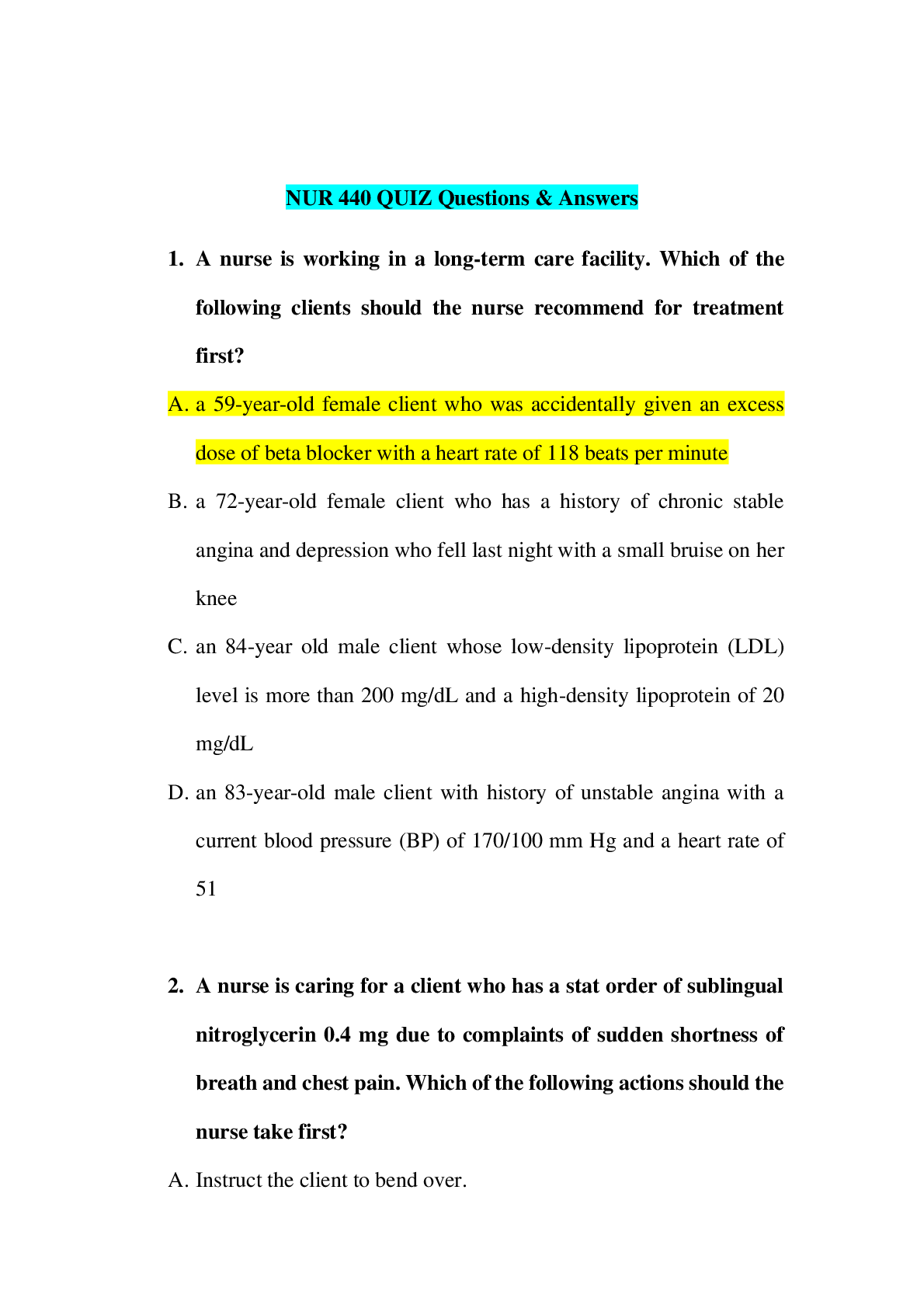
Buy this document to get the full access instantly
Instant Download Access after purchase
Add to cartInstant download
Reviews( 0 )
Document information
Connected school, study & course
About the document
Uploaded On
Jun 16, 2020
Number of pages
14
Written in
Additional information
This document has been written for:
Uploaded
Jun 16, 2020
Downloads
0
Views
89

.png)



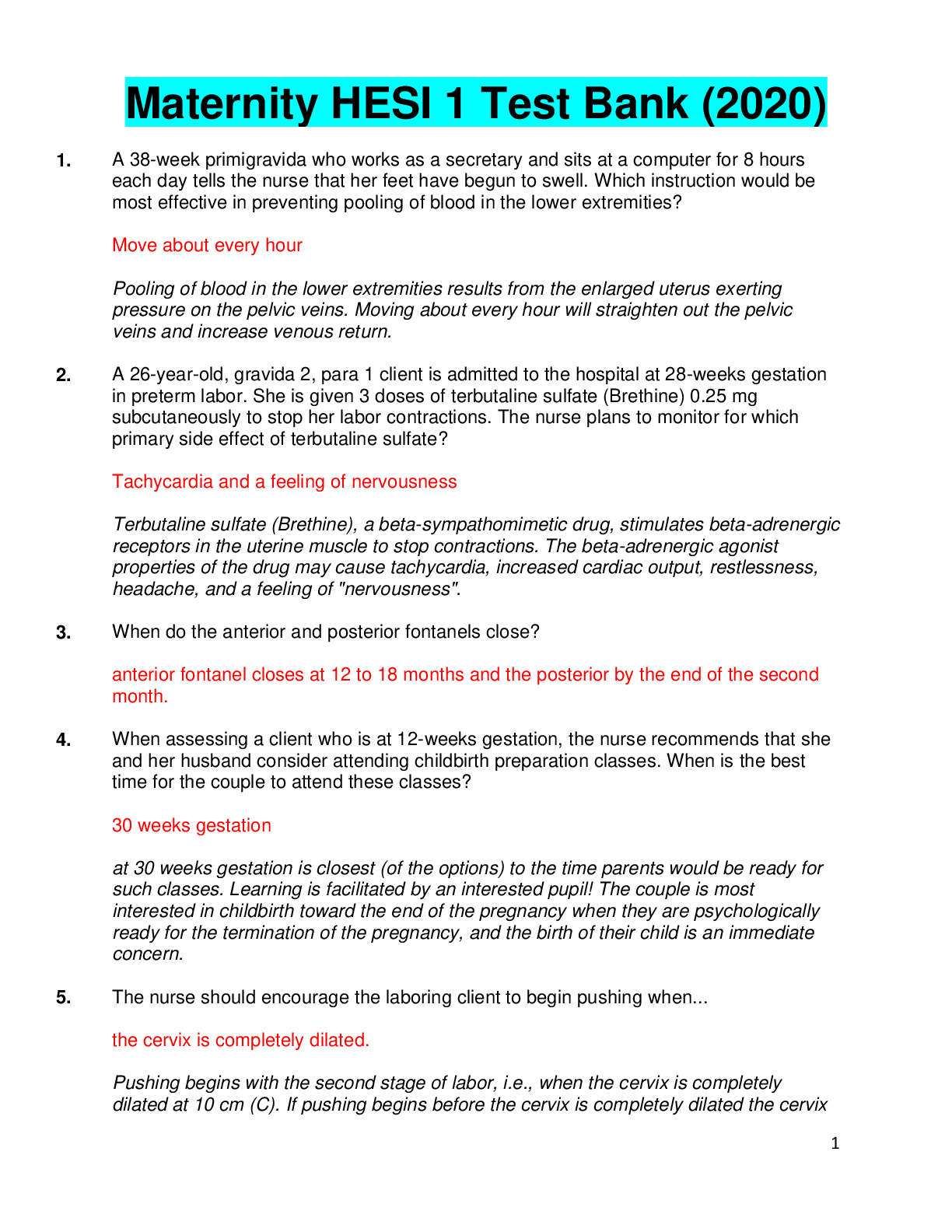

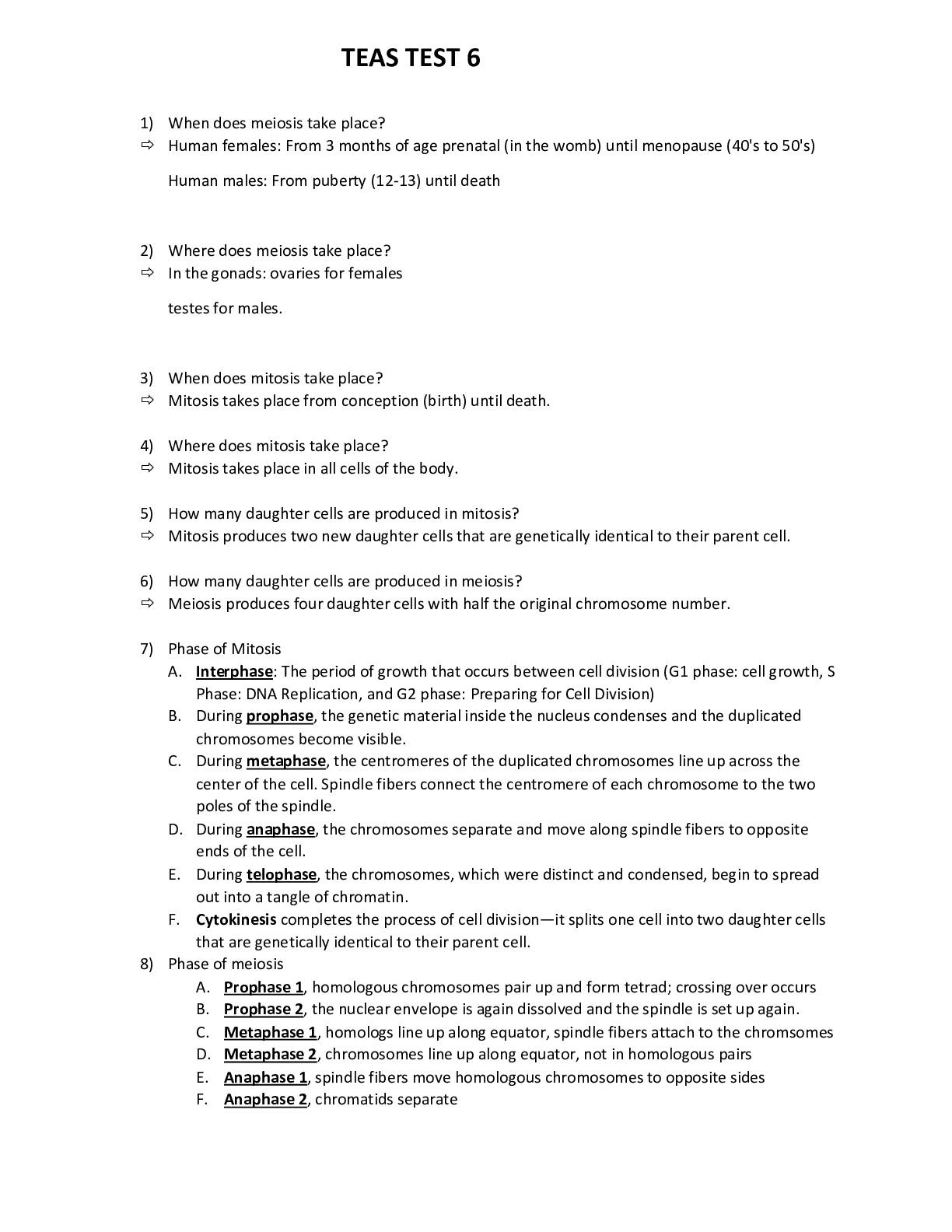
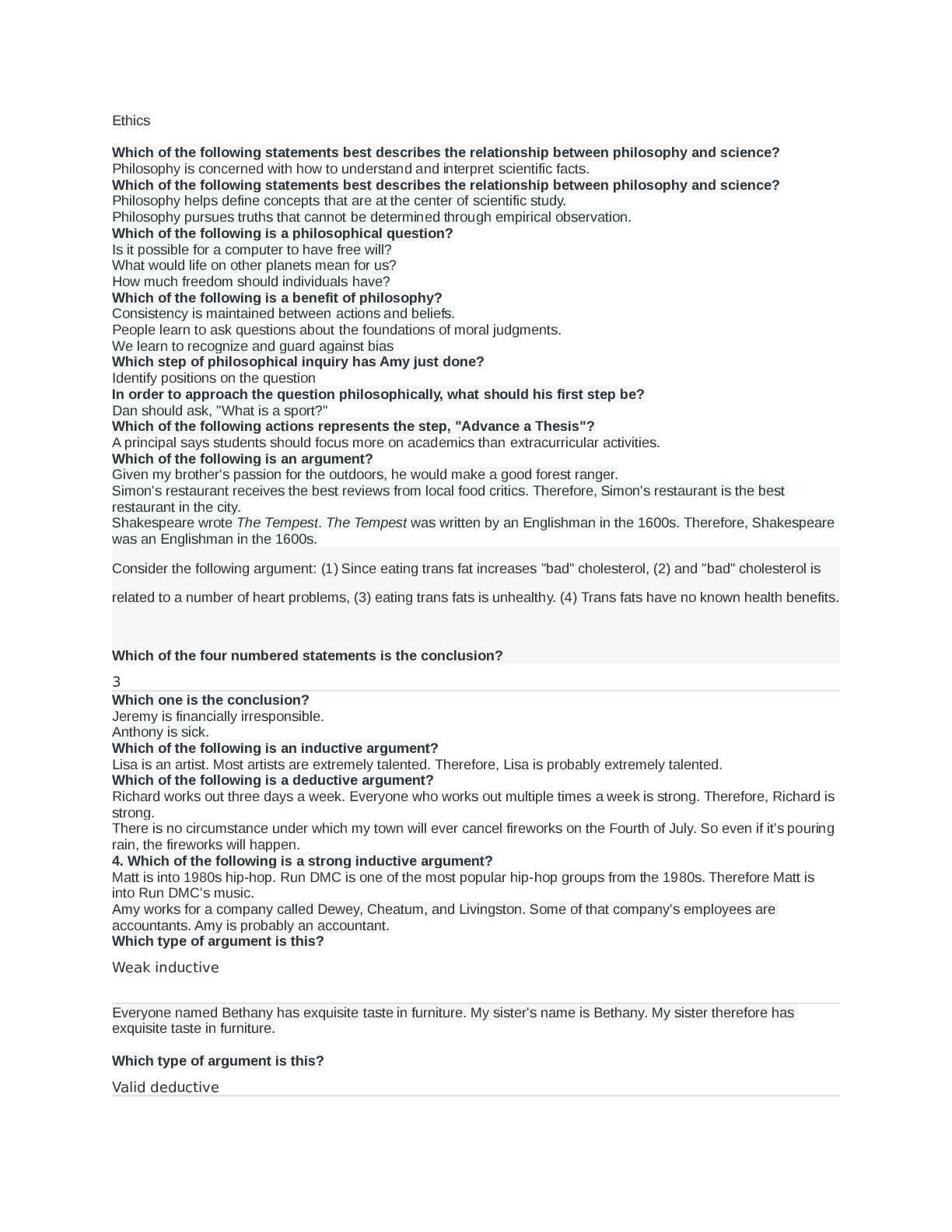


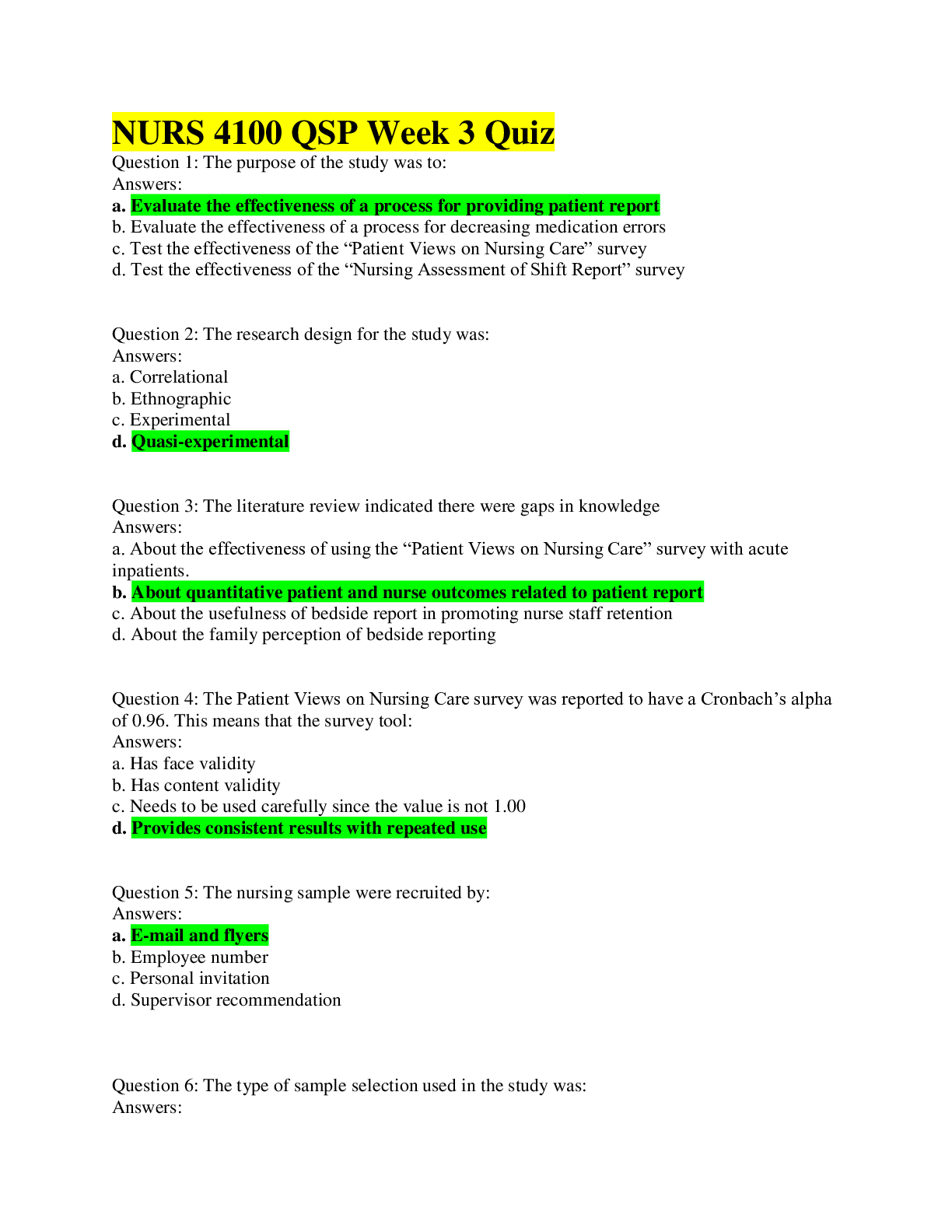
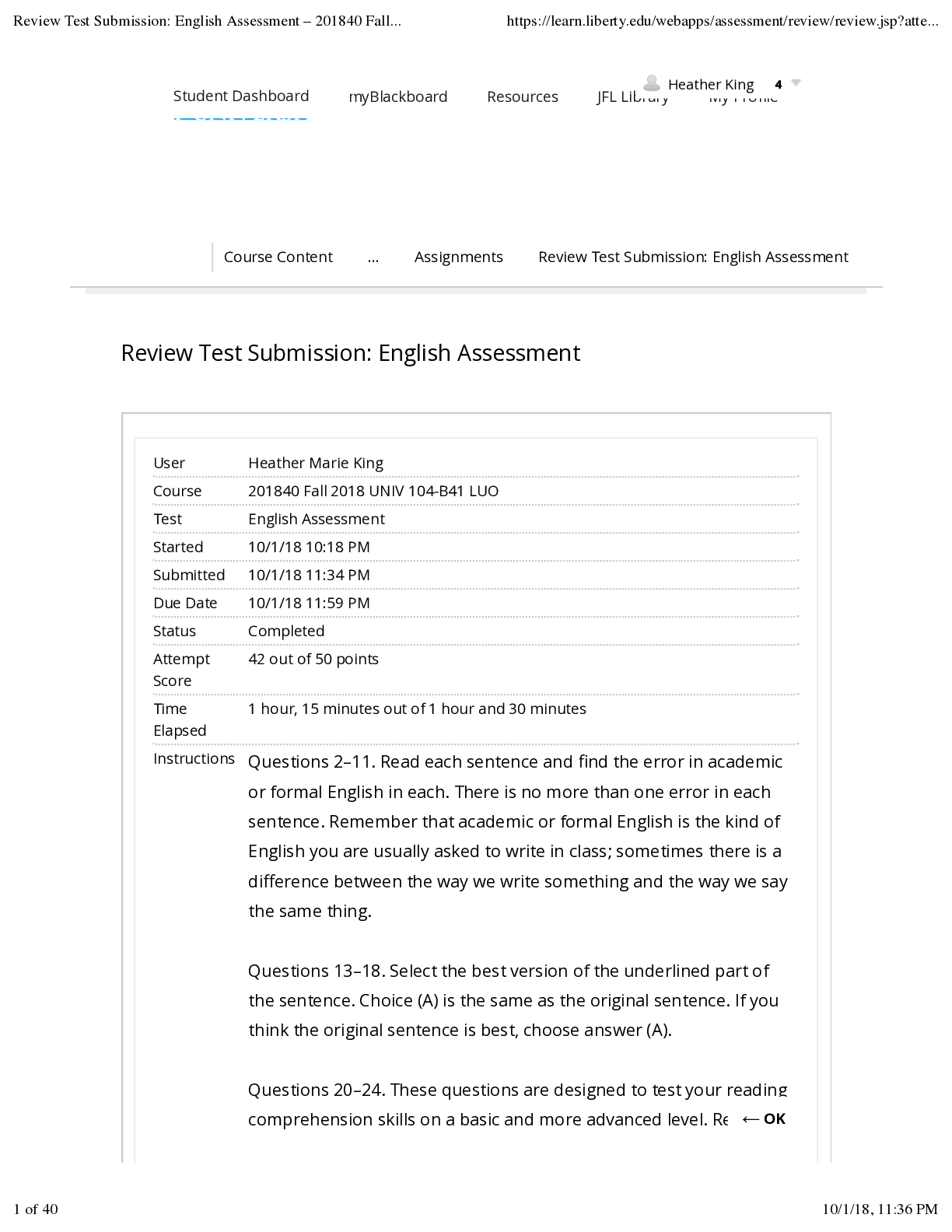
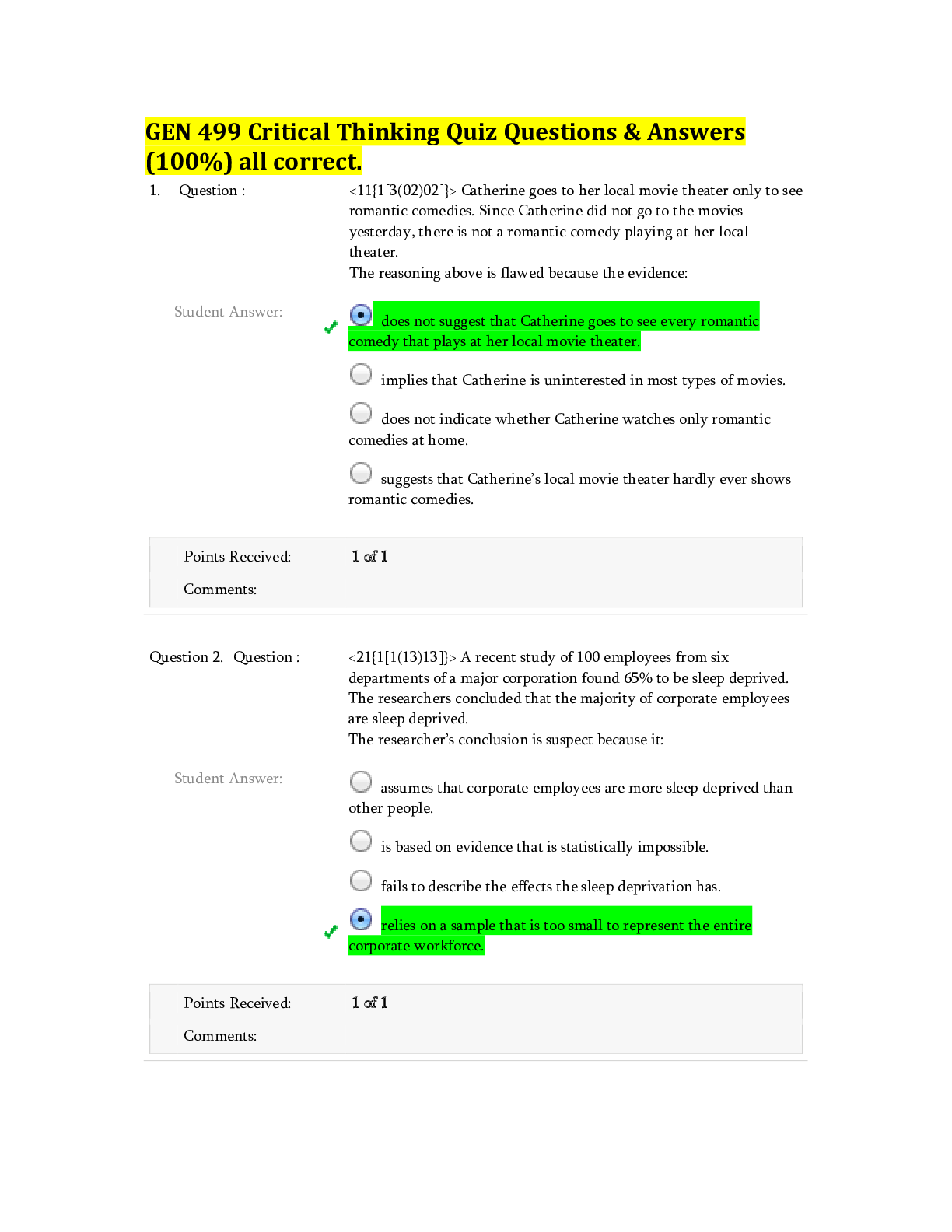
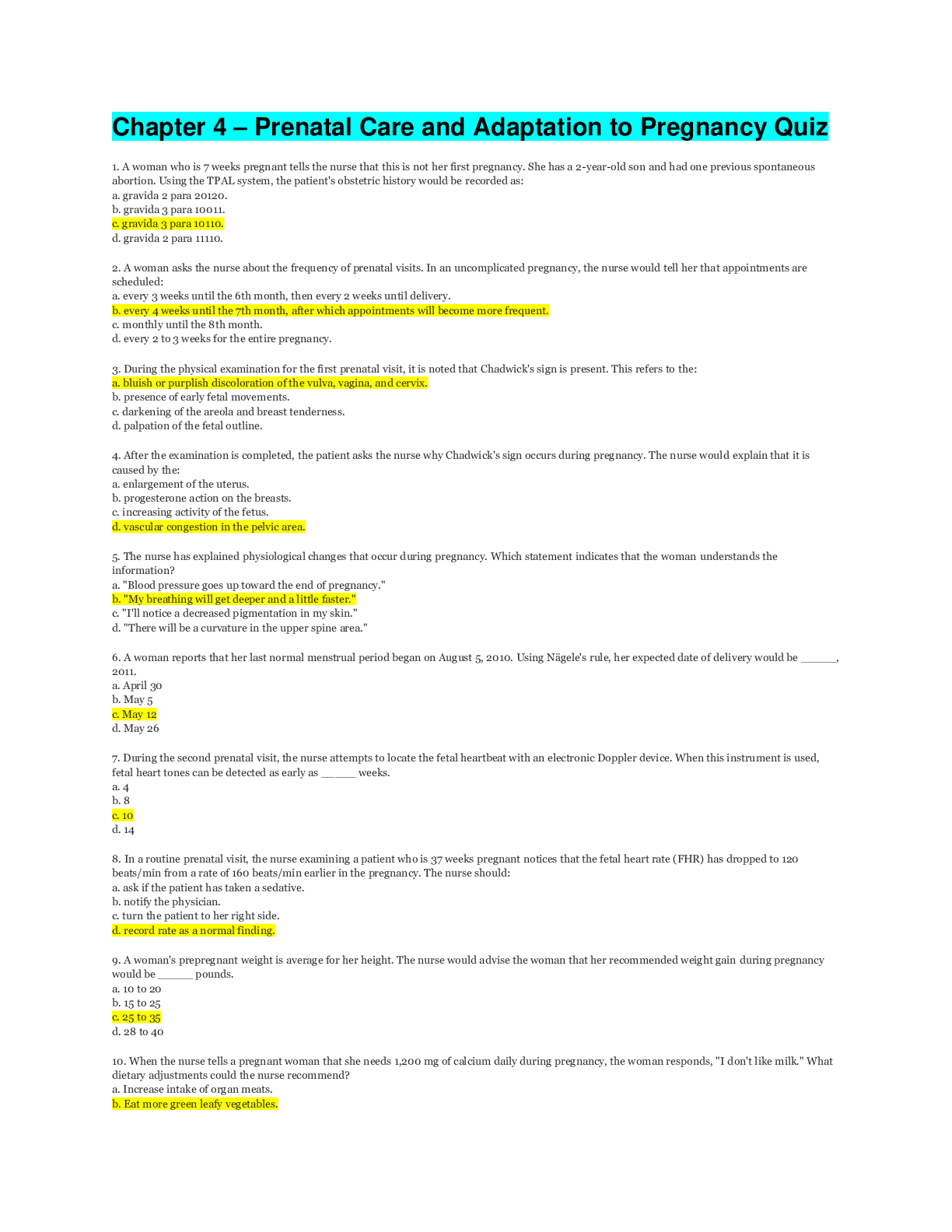
.png)
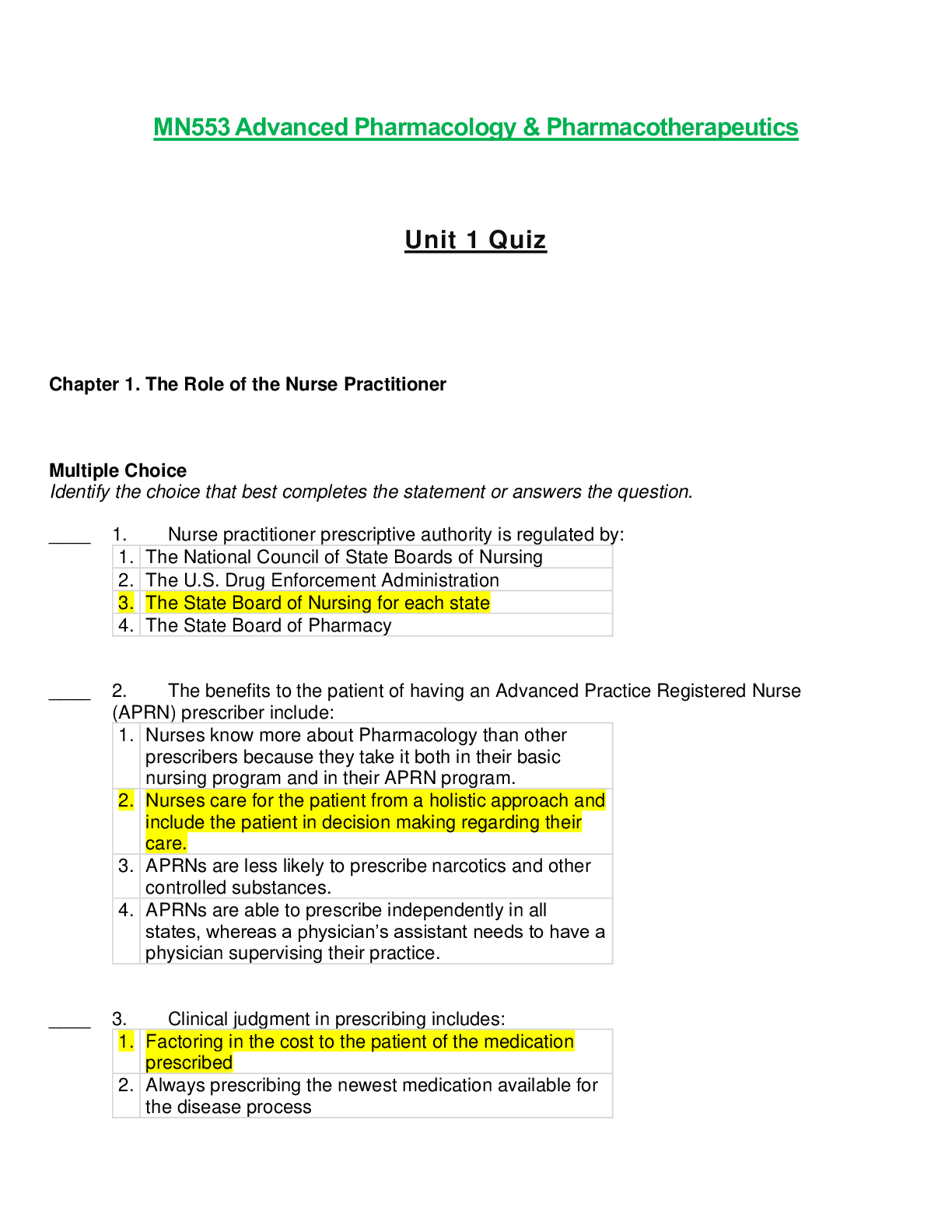


.png)
